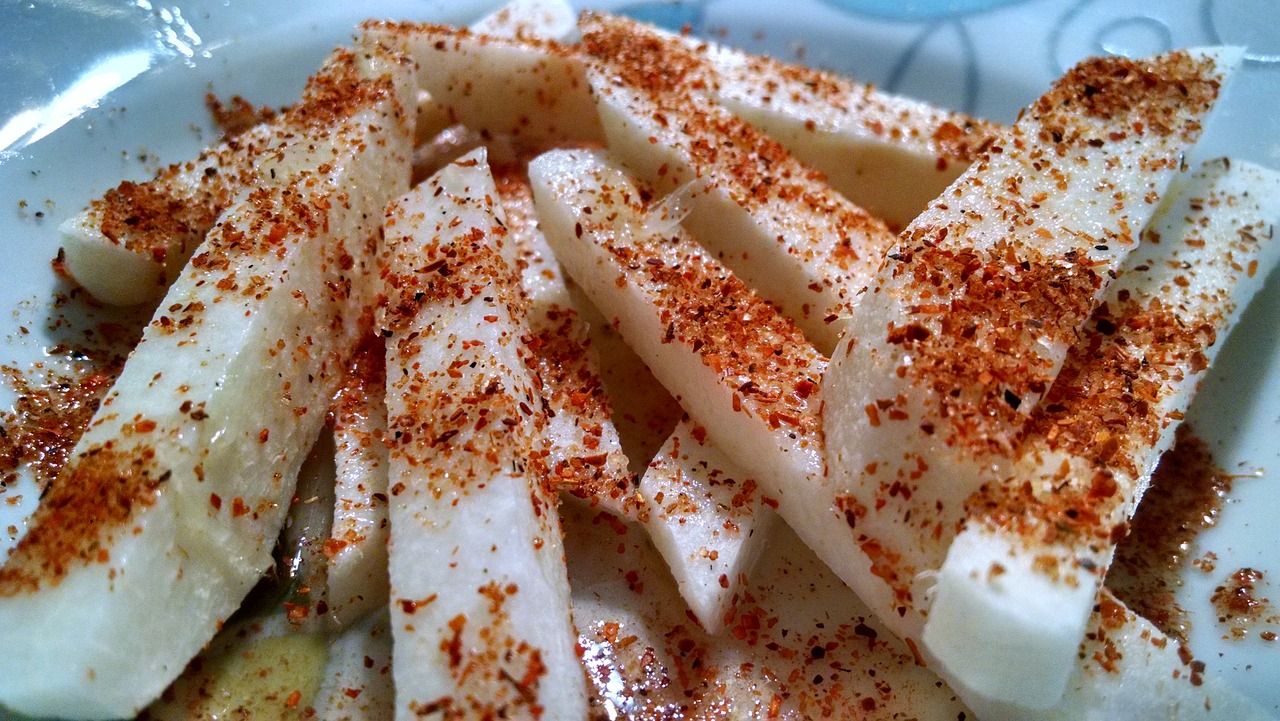Jicama, also known as Mexican yam bean or Pachyrhizus erosus, is a unique root vegetable that has gained popularity in recent years, especially among health enthusiasts and culinary adventurers. Native to Mexico and Central America, jicama is prized for its crunchy texture, mildly sweet flavor, and impressive nutritional profile. In this article, we’ll explore the origins, nutritional benefits, culinary uses, and tips for incorporating jicama into your diet.
Origins and Growing Conditions
Jicama is a member of the legume family and is cultivated primarily for its edible tuberous root. The plant grows in warm climates and is well-suited to sandy or loamy soils. It thrives in temperatures between 60°F and 90°F (15°C to 32°C) and requires a long growing season, typically around six months. Jicama is primarily grown in Mexico, where it is a staple in many traditional dishes, but it is also cultivated in the southern United States, especially in Texas and California.
The jicama plant produces large, heart-shaped leaves and delicate white flowers. However, the part most sought after is the underground tuber, which can weigh several pounds and is typically round or bulbous in shape with a smooth, brownish skin. The flesh inside is white and crisp, similar to a turnip or apple, making it a refreshing addition to a variety of dishes.
Nutritional Profile
One of the most appealing aspects of jicama is its impressive nutritional profile. It is low in calories but high in essential nutrients, making it an excellent choice for those looking to maintain a healthy diet. A one-cup (120-gram) serving of raw jicama provides approximately:
- Calories: 46
- Carbohydrates: 11 grams
- Fiber: 6 grams
- Protein: 1 gram
- Fat: 0.1 grams
- Vitamin C: 44% of the Daily Value (DV)
- Potassium: 6% of the DV
- Folate: 4% of the DV
Jicama is particularly notable for its high fiber content, which can aid digestion and promote feelings of fullness. The high vitamin C content supports immune health and acts as an antioxidant, while potassium is essential for maintaining healthy blood pressure levels.
Health Benefits
The health benefits of jicama extend beyond its impressive nutrient content. Here are some key benefits:
1. Digestive Health
The high fiber content in jicama is beneficial for digestive health. Fiber helps promote regular bowel movements, preventing constipation and supporting a healthy gut microbiome. Additionally, the fiber in jicama can help regulate blood sugar levels, making it a good choice for individuals with diabetes or those looking to manage their weight.
2. Hydration
Jicama is composed of about 90% water, making it an excellent hydrating snack. Staying hydrated is crucial for maintaining energy levels, promoting skin health, and supporting overall bodily functions. Snacking on jicama can help keep you refreshed, especially in hot weather.
3. Weight Management
Low in calories but high in fiber and water content, jicama can help you feel full and satisfied without adding excessive calories to your diet. Incorporating jicama into your meals or snacks can aid in weight management and reduce the likelihood of overeating.
4. Antioxidant Properties
Jicama contains various antioxidants, including vitamin C and certain phytonutrients. These compounds help neutralize harmful free radicals in the body, reducing oxidative stress and lowering the risk of chronic diseases.
Culinary Uses
Jicama’s mild flavor and crunchy texture make it incredibly versatile in the kitchen. Here are some popular ways to enjoy jicama:
1. Raw Snacks
Jicama is often eaten raw, making it an ideal crunchy snack. You can slice it into sticks or cubes and serve it with dips like hummus, guacamole, or salsa. Its refreshing taste makes it a great addition to vegetable platters.
2. Salads
Jicama adds a delightful crunch to salads. Consider adding thinly sliced jicama to green salads for an unexpected twist or combining it with citrus fruits like oranges and grapefruits for a refreshing salad.
3. Salsas and Dips
Jicama can be diced and incorporated into salsas, adding a crunchy texture that complements the other ingredients. Combine it with tomatoes, onions, cilantro, lime juice, and jalapeños for a zesty salsa. You can also mix it with avocado for a unique guacamole twist.
4. Stir-Fries and Cooked Dishes
Although jicamas is often enjoyed raw, it can also be cooked. When sautéed or stir-fried, jicama retains its crunch while absorbing the flavors of the dish. It pairs well with a variety of proteins and vegetables in stir-fries or as a substitute for water chestnuts in Asian dishes.
5. Tacos and Wraps
Jicamas can serve as a low-carb alternative to tortillas in tacos and wraps. Slice it into thin rounds or strips and use them as a base for your favorite fillings, such as grilled chicken, vegetables, and salsa.
How to Choose and Store Jicama
When selecting jicamas, look for firm, heavy tubers with smooth, unblemished skin. Avoid any jicama that feels soft or has dark spots, as these may indicate spoilage. Store jicamas in a cool, dry place, such as a pantry or root cellar, for up to two weeks. Once cut, jicama should be stored in an airtight container in the refrigerator, where it can last for several days.
Conclusion
Jicama is a versatile and nutritious root vegetable that deserves a place in your diet. Its mild flavor and crunchy texture make it suitable for a wide range of dishes, from raw snacks to cooked meals. With its impressive nutritional profile and numerous health benefits, incorporating jicamas into your meals can contribute to a healthier lifestyle. Whether you enjoy it as a snack, in salads, or as a substitute for traditional ingredients, jicamas is a delightful addition to any culinary repertoire. So, the next time you’re looking for a refreshing and nutritious ingredient, consider giving jicamas a try!
